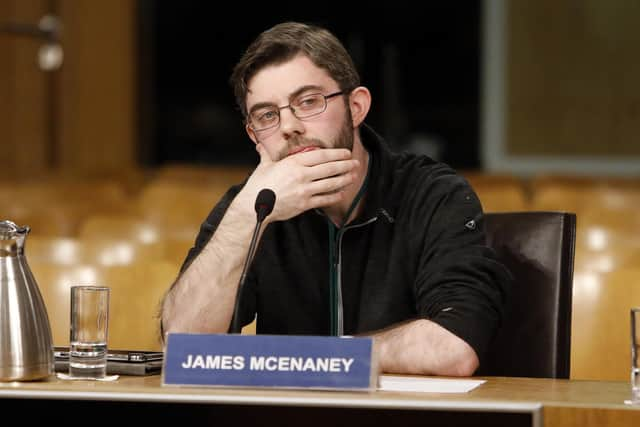Insight: How rank and file teachers feel about education reform in Scotland
A single bad report acted as the spur for change, but in a school where teachers were already committed to doing their best, the shift came elsewhere.
Staff took on increased paperwork, diligently updated tracking data and filled out numerous excel spreadsheets. None of it impacted on, let alone improved, day to day teaching, but when the inspectors next visited, the follow-up report was, in his words, “glowing”.
Advertisement
Hide AdAdvertisement
Hide AdLooking back, he says, it was indicative of a system ripe with potential, but one that came to place its trust in performativity measures as opposed to teachers.
Others on the ground in primary and secondary schools across Scotland tell similar stories, describing how an audit-driven, technocratic approach has left a once world-class education system strangled by red tape.
In truth, such concerns have been ever present since the rollout of Curriculum of Excellence (CfE), a much misunderstood educational narrative designed to empower practitioners with the freedom and flexibility over what to teach, and how to teach it.
But what was envisioned as a landmark development in Scottish education increasingly resembles a mere staging post, with the promise of further, and perhaps even bolder, reform on the horizon.
The catalyst for that was last week’s independent review of CfE by the Organisation for Economic Co-operation and Development (OECD).


While praising the vision and philosophy underpinning the framework, the Paris-based body pinpointed an array of problems, from a paucity of time for teachers to prepare lessons and a constant “recycling” of guidance, to a lack of an evaluation strategy and a crippling disconnect between CfE and the qualification-focused later years of schooling.
In the immediate aftermath of its publication, the Scottish Government announced the Scottish Qualifications Agency (SQA) would be replaced, with the Education Scotland agency shaken up as part of what education secretary Shirley-Anne Somerville promised would be a “substantial” overhaul.
But what will that overhaul look like?
For those with direct experience of teaching in primary and secondary classrooms across the country, there is a sense of opportunity tinged with scepticism.


Advertisement
Hide AdAdvertisement
Hide AdFor Mr McLauchlan, who spent 16 years as a primary teacher across three local authorities, the release of another critical report on Scottish education is a time to reflect on fundamentals.
“We must not lose sight of the core purpose of education,” he said. “Helping all our students to flourish.”
‘We need to give teachers space, time and resources’
If there are doubts over the system’s capacity for change, it is not difficult to understand why.


Few of the substantive concerns identified by the OECD could be described as new.
As far back as 2013, a dedicated CfE working group on tackling bureaucracy warned that over-detailed planning processes, assessment systems which were not fit for purpose, unnecessary auditing, and unclear expectations were the main drivers of “excessive bureaucracy”.
A follow-up report two years later found while progress had been made, more needed to be done around forward planning, assessment, self-evaluation processes, and monitoring and reporting.
While the debate around the OECD review has focused predominantly on exams, those who have closely scrutinised CfE’s implementation point to deeper, structural problems.
“The reality is we don’t have CfE in Scotland,” said James McEnaney, a former secondary teacher turned lecturer, journalist and author.
Advertisement
Hide AdAdvertisement
Hide Ad“Every day, every teacher in Scotland goes home knowing that they’ve effectively been forced to let down their pupils, because they don’t have time to improve things.”
That, Mr McEnaney believes, is the crucial factor behind CfE’s woes.
The OECD review highlighted how teachers needed less class contact time to translate curriculum policy documents into reality in the classroom. Mr McEnaney emphatically agrees.
“Scotland is an international outlier when it comes to the amount of classroom teaching we expect teachers to do,” he said.
“It makes it impossible for them not just to plan, but to do the basics of the job as well as possible.
“You can’t plan an effective lesson without reviewing what’s gone before. What you should be doing to arrange Monday’s lesson is going through Thursday’s work and looking for any shared misunderstandings.
“The thing people need to grasp about educational improvement is that it doesn’t involve improving either schools or teachers – it’s about improving teaching, which is not the same thing. The only way to do that is to give teachers the space, time and resources they need.”
How that change can be put into practice will be the focus of considerable discussion.
Advertisement
Hide AdAdvertisement
Hide AdDr Patrick Roach, general secretary of the NASUWT teachers’ union, said it could not be a “cosmetic exercise” or a “quick fix,” with a need to “examine the whole system in the round”.
Larry Flanagan, general secretary of the EIS union, said it could be achieved by focusing on exit qualifications rather than annual exams, and studying across two year courses – such as S4 and S5 – before formal qualifications.
“Until the issue of teaching and learning time is cracked, changing assessment approaches will be insufficient to meet the challenges,” he warned.
Others believe the debate should address the dwindling number of subject choices and the lack of regular CfE review cycles, or go even further to revisit issues such as class sizes, school starting ages, and the feasibility of a middle school system to solve tensions around the transition from primary to secondary.
Data inputting and red tape
The lack of time goes hand in hand with onerous administrative demands.
One classroom veteran pointed out that experienced head teachers devote significant effort to drawing up staffing timetables. “It’s a task which could easily be done by an administrator,” they said. “It saps the resources of experienced educators.”
Mr McLauchlan, whose career includes a stint as a principal teacher and a development officer seconded to Education Scotland, said while he relished times when he felt “empowered and autonomous” as a teacher, the deluge of benchmarks and guidance ushered in by CfE left him “overwhelmed”.
“I was trying to make literal sense of often confusing and vague language expressing learning outcomes in the CfE experiences and outcomes,” he recalled.
Advertisement
Hide AdAdvertisement
Hide Ad“Rather than being a clear and adaptable framework for use across schools, CfE quickly became more like a sticky web of overloaded information that schools no longer had the energy, time or capacity to enact.”
One serving head teacher at a west of Scotland secondary school said the biggest drain on his staff’s time and energy was SEEMiS, an education management information system in place across all of Scotland’s 32 local authorities, which effectively tracks a range of datasets for every child in the country.
“There is an obsession with collating as much data as possible, which, in and of itself, is not necessarily a bad thing, but it only has purpose if that data is applied meaningfully,” they explained.
Robert Macmillan, who teaches modern studies, said CfE had ushered in administrative rather than educational change, with more time spent inputting tracking data than having meaningful conversations with pupils about their learning.
“Where we had been promised continuous assessment, we were given continuous bureaucracy,” he said.
“I fear that unless the people at the top are sidelined – those who have benefited from promoting the current mess through promoting themselves – we’ll only see more of the same.”
Mr McEnanay, whose new book on Scotland’s schools system is due to be published by Luath Press in August, said teachers need system-wide support “from the centre,” pointing out that in the last – and final – Scottish Survey of Literacy and Numeracy (SSLN) survey, around three quarters of teachers said they had not had the chance to go into another school to observe good practice over the previous year.
“Fundamentally, CfE empowers teachers as creators of a curriculum, and not deliverers of it,” he said.
Advertisement
Hide AdAdvertisement
Hide Ad"That is a good thing, and in theory, it means they can adapt their teaching materials to suit their classes, as long as they can tie it to the curriculum.
“The Holy Grail of that is that teachers should be able to put in place bespoke assessments which embed seamlessly with their teaching. However, it’s an impossible amount of work under the current system.
"There are more than 1,000 experiences and outcomes in CfE, and they lead to an atomised, box-ticking approach.”
Tackling the attainment gap
An issue that has barely been broached since the release of the OECD report is how the future shape of Scottish education will make inroads into tackling the nation’s persistent poverty-related attainment gap.
Michael Shanks, a secondary school teacher in Renfrewshire, singled out the OECD’s observation that educational reform alone will not reduce the gap, with the need for “broader coalitions” across welfare, housing, and health policy.
“All of the discussion about Education Scotland and the SQA is important, but none of it touches on the public policy issues about poverty, wellbeing at home, and family support,” he said.
“Our response to tackling the attainment gap shouldn’t just be focused on schools, it’s about supporting young people in their lives outside school.”
Mr Shanks used to work for Includem, the youth support charity behind a pioneering project in Dundee’s schools that helped children who were at risk of exclusion or going into care.
Advertisement
Hide AdAdvertisement
Hide AdAt the time of its inception, the city had one of the highest school exclusion rates in Scotland, but the widely lauded intervention model – which offered intensive support around issues including behaviour, wellbeing and family – reduced the rate to among the lowest in the country.
With the OECD report inviting transformative reform, Mr Shanks believes there is an opportunity to embed such a support network in a revamped system.
Interventions such as the Scottish Attainment Challenge and Pupil Equity Funding, he pointed out, need to be directed not just at schools, but to families of pupils most at risk of exclusion.
“Kids spend most of their lives outside school, and if we’re going to close the poverty-related attainment gap, it has to happen outside of school,” he said.
“If we want to realise the savings of children being in school, attaining and going to a positive destination, we need to find the money from somewhere. That’s difficult, but it’s absolutely necessary.”
In Mr McLauchlan’s view, the government’s commitment to closing the gap was as much about holding teachers to account.
The disharmony in curriculum implementation between policy and practice, he said, led to a renewed focus on system effectiveness, teacher performativity and political accountability.
“Teacher trust eroded, and there was a battle in the policy documents between teacher autonomy and effectiveness,” he explained.
Advertisement
Hide AdAdvertisement
Hide AdWhen the SSLN and the Programme for International Student Assessment flagged falling levels, Mr McLauchlan said the response was to “sidetrack teacher trust” by rolling out standardised assessments.
“The National Improvement Framework and closing the gap rhetoric similarly wanted to place the entire responsibility for fixing societal inequalities on teachers’ shoulders without properly acknowledging the holistic overview and systemic realities of the complex roots and foundations of poverty in Scotland,” he said.
“I agreed completely with the substance of the closing the gap policy, but the methods, means and deeper understanding of the problem were completely skewed.”
Time will tell what change looks like, and whether it engages with the wider societal issues flagged by Mr Shanks and Mr McLauchlan.
The Scottish Government has already appointed Professor Ken Muir, until recently the chief executive of the General Teaching Council for Scotland, to oversee the creation of a SQA successor responsible for both curriculum and assessment.
Mr Muir is generally well regarded, but Mr McEnaney has concerns the reality of reform will simply parachute well-kent faces into new roles, with revamped organisational logos.
“The OECD, an inherently conservative organisation, is telling Scotland to pursue a really radical, progressive process of reform, one which is potentially exciting, and certainly difficult and complicated,” he said.
“They’re doing that because we know reforms like these work. The question now is can the SNP and the Scottish education establishment shake off its conservatism? Personally, I don’t think it can, but I’ll happily be proved wrong.”
A message from the editor:
Thank you for reading this article. We're more reliant on your support than ever as the shift in consumer habits brought about by coronavirus impacts our advertisers. If you haven't already, please consider supporting our trusted, fact-checked journalism by taking out a digital subscription.
Comments
Want to join the conversation? Please or to comment on this article.
